Sony VAIO SE: An IPS Laptop for Under a Grand
by Jarred Walton on April 3, 2012 5:40 PM ESTSony VAIO SE Application Performance
Sony opted to ship us a higher spec variant of the VAIO SE, which of course helps out with their ranking in some of the benchmarks. Even so, the base model Core i5-2450M is hardly a slouch in performance. The i7-2640M we’re testing is clocked 12% higher and can Turbo Boost 13% higher, so unless you really need every bit of performance you can wring out of your CPU, we’d suggest sticking with the i5-2450M. A far better use of $210 (the cost to upgrade to the i7-2640M) would be to switch to an SSD, as that will add far more than 12% better performance to many mundane tasks, and SSDs aren’t prone to fragmentation and the horrible sluggishness that plagues PCs after a year or so of heavy use.
As usual, we’ve got several laptops with SSDs in the charts below, and those will rise to the top in tests like PCMark. Other tests will focus more on pure CPU or GPU performance. If you’re wondering how the base model VAIO SE might perform, look at the VAIO SB results—the HD 6470M and i5-2410M are close enough to what you’ll get from the SE that it should help set your expectations. We also have a couple higher-end laptops/notebooks in the charts, but the main reason we’re including the HP EliteBook 8760w is for the LCD comparison later on in the review.
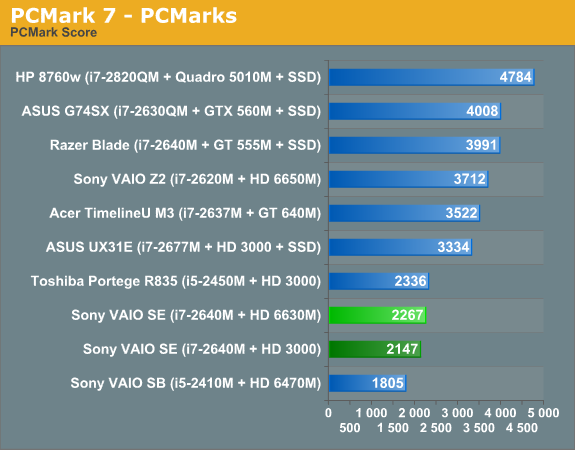


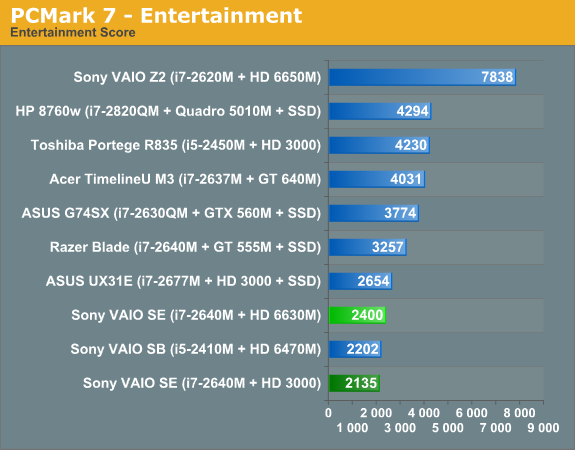

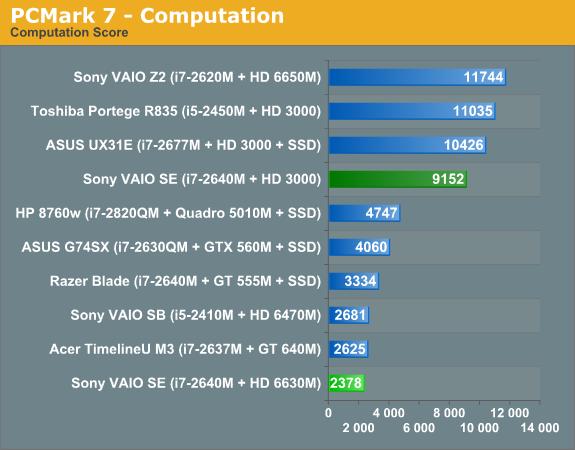
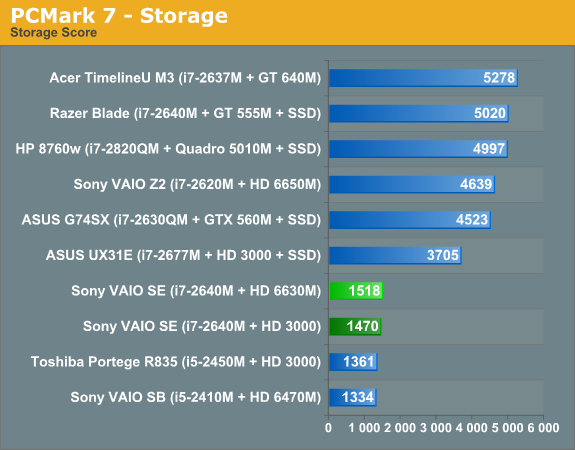
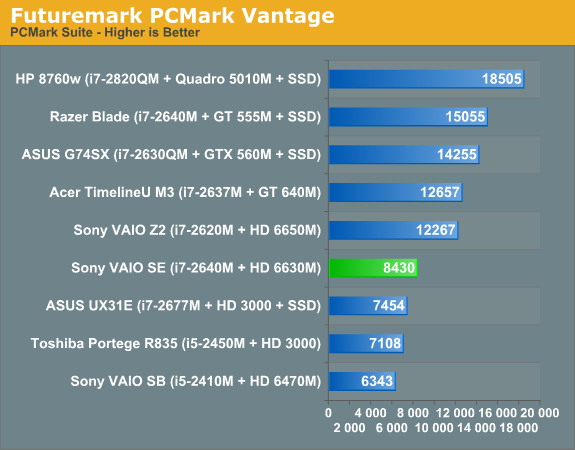
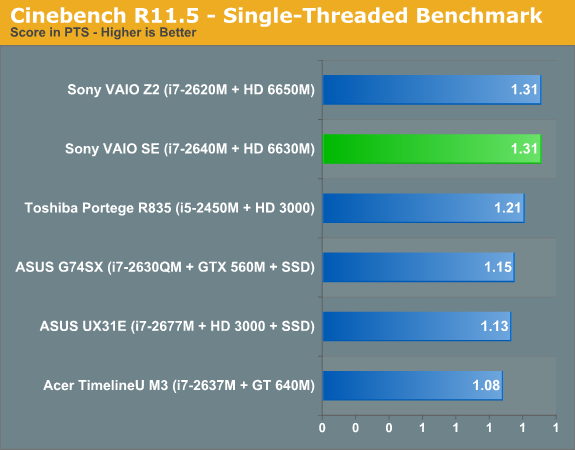
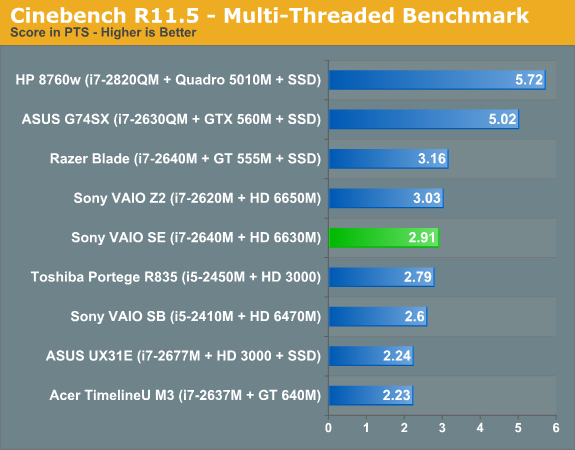
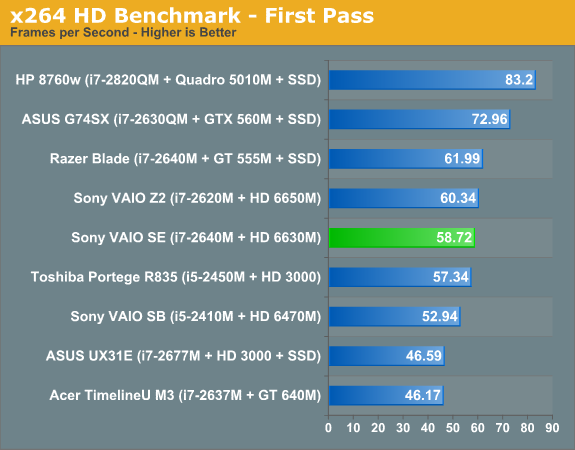

There’s not a whole lot to say about the performance. The VAIO SE falls right about where you’d expect given the configuration we’re testing. It’s interesting to point out that the Razer Blade uses the same CPU as the SE, with a GPU that’s certainly faster and a chassis that provides a bit more cooling potential. Optimus also allows you to dynamically switch between the IGP and dGPU, and we’ve used the dGPU results for PCMark 7 so certain tasks that can use Quick Sync (e.g. Computation and Creativity) take a hit. PCMark 7 and Vantage benefit quite a bit from the presence of an SSD; the closest the VAIO SE gets to the Razer Blade is the IGP Computation score, where the Blade still leads by 31%. Some of that most likely comes from drivers as well, but we can’t say for certain how much is drivers, how much is cooling, and how much is the SSD.
Something else to pay attention to in the CPU-centric benchmarks is how the various dual-core i7 laptops stack up. The VAIO SE and Razer Blade both use the newer i7-2640M while the VAIO Z2 we tested has an i7-2620M; that should result in the SE coming in ahead of the Z2, but Cinebench and x264 encoding both have the Z2 and Blade leading the SE by a small margin. This is likely a result of CPU thermals preventing the SE from hitting maximum Turbo Boost frequencies as often, which is quite surprising considering the Z2 is a 13.1” chassis while the SE is a 15.5” design.
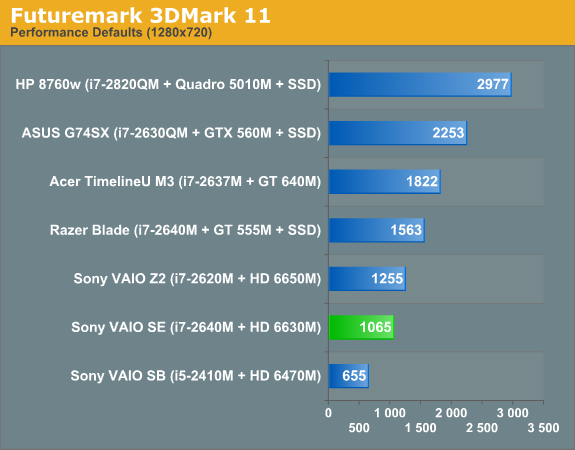

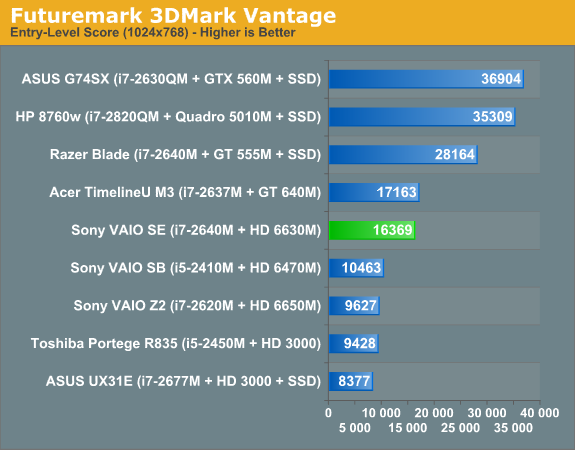
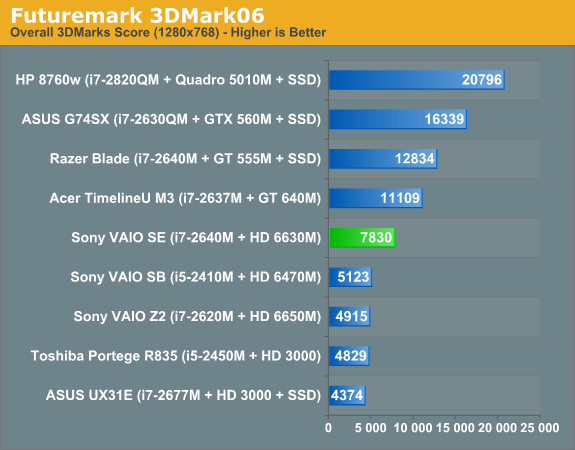
As for 3DMarks, again performance is about what you can expect from the HD 6630M. The VAIO SE clearly isn’t intended as a gaming laptop—particularly if you opt for the base model with HD 6470M graphics—but it can still handle most games at lower resolutions and medium detail. There are also a couple odd results where the 6630M in the SE comes out significantly ahead of the 6650M in the Z2. That could be partly a case of different drivers, but more likely is that the external GPU can’t reach maximum performance while piping content back to the integrated 1080p displays. As for what this means for playing games, let’s get to the actual gaming benchmarks and see what happens.










59 Comments
View All Comments
peterfares - Tuesday, April 3, 2012 - link
1 4GB stick of RAM costs $20 or less. Just order it without any RAM stick and put the 4GB module in, leaving you with 2x4GB=8GB. 2GB soldered on would have been horrible. I'm already sick of 8GB and want 16GB in my laptop. I will when I get a sandy or ivy bridge laptop. My arrandale only supports 8GB.piroroadkill - Tuesday, April 3, 2012 - link
A perfectly serviceable specification and a great display, for a reasonable enough price.Everyone else needs to pay attention..
bunnyfubbles - Tuesday, April 3, 2012 - link
the screen, relative light weight (you'd be hard pressed to find any other 15+" lappy @ 5.4lbs let alone 4.4), and price really were what sold it for meI was going to go with the 13.3" S series for its portability, and while the 13.3" S series 1600x900 screen was definitely a cut above all other PC laptops that are stuck with 1366x768, the 1080p IPS of the SE really was that much more gorgeous when comparing them side by side in store.
The HDD is a disappointment, however I just upgraded my desktop from a 128GB Crucial M4 to a pair of Samsung 830s, so I was able to plug that M4 into the laptop, as well as replace the 2GB module with a 4GB (was less than $20) for 8GB total. Those two simply hardware upgrades along with a reformat with only the essential software and drivers (all of which can be found pretty easily and conveniently from Sony's support site) lead to a very awesome overall computing experience.
The last upgrade I did was grabbed an external USB DAC. The Speakers on this laptop are extremely anemic, and the onboard sound leaves much to be desired. I have a Creative X-Fi GO! (was less than $30) for when gaming and chatting (has both plugs for headset and mic, laptop itself has only one jack so you can't have both headset and mic, and thus would have to rely on the built in mic on the laptop which is passable but not ideal) and my trusty FiiO E7 when just watching movies or listening to music
The 128GB SSD might not seem like much, but its certainly enough for the OS and apps, and no laptop will be able to satiate my gaming like my desktop, so very few games get installed to it anyway. Anything else (mostly large media files such as music and movies) can be handled via portable USB HDDs and flash thumbdrives, of which I converted the 640GB HDD to a portable drive with a portable 2.5" USB3.0 enclosure.
jigglywiggly - Tuesday, April 3, 2012 - link
I'd take the tn panel 95% ntsc color gamut (The clevo one you were talking about) I have one in my np8130 and it is absolutely amazing. Contrast and brightness is most important thing imo, then viewing angles.piroroadkill - Wednesday, April 4, 2012 - link
I disagree. You're not going to be using a laptop for serious colour sensitive work, but you might have a laptop out to watch a video with a few friends sat around it.charleski - Wednesday, April 4, 2012 - link
On TN panels the gamma changes (usually dramatically) with even a slight movement off-axis. They're completely unsuitable for colour-sensitive work unless you're going to lock your head at the optimum position.There certainly are people who need a decent portable screen for reviewing images, but the available options are very limited.
Stacey Melissa - Tuesday, April 3, 2012 - link
I'm not quite as worried about the hinge, but after three months with my base SE, I agree with the rest of the review, for the most part. I immediately swapped the HDD for a 128GB Crucial M4, and did a clean Win7 install, so performance is pretty good. I only get about 4 to 4.5 hours runtime, but I'm running the screen at fairly high brightness (82%) and turned off a couple obscure power-saving tricks. I'm very picky about noise. Luckily, fan noise is very low for my typical use, which involves browsing, Visual Studio, and video playback. I usually use a Targus wedge laptop cooler, which I don't plug in. Clicks are noisy. The trackpad is placed too far to the right, and I really miss two-finger scrolling. The keyboard is excellent, except for the spacebar, which often doesn't register left-side presses. It could use dedicated volume buttons. I like the manual graphics switching, except that it takes several seconds.Bugs: Scrolling usually quits working after waking from hibernation. To fix, open the mouse control panel, and click OK. The BT hardware sometimes quits working upon resume, even after the driver update that supposedly fixes it. When running on battery, the DVD drive switches on and off regularly and often, which causes the standard hardware attachment/detachment sound notification.
The screen is easily the best I've used on a laptop. It also bests my old Dell 2405 desktop S-IPS in brightness, contrast, and of course sharpness, but not quite in gamut or accuracy.
adece - Tuesday, April 3, 2012 - link
...is actually appealing! What do you knowMrMaestro - Tuesday, April 3, 2012 - link
I bet Dustin wouldn't have minded getting his hands on this laptop to review, how did AnandTech decide who had dibs? Coin toss? Rock-paper-scissors? Fight to the death?JarredWalton - Tuesday, April 3, 2012 - link
Dustin got the Z2, I got the SE... wasn't sure which would be better, but ultimately the Z2 is too costly for what you get and the keyboard doesn't appeal as much.